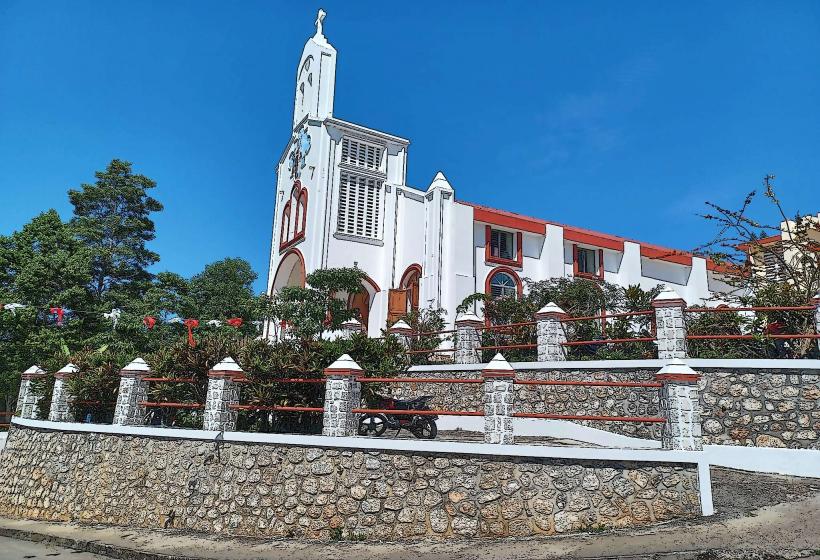Information
Landmark: Jacmel Art CenterCity: Cayes Jacmel
Country: Haiti
Continent: North America
The Jacmel Art Center (Centre d'Art de Jacmel) is a prominent cultural institution located in Jacmel, a city in the Sud-Est department of Haiti, known for its rich history and vibrant art scene. The center plays a crucial role in promoting and preserving Haitian art and culture, particularly the traditional crafts and artistic expressions that are deeply rooted in the city’s heritage.
Key Aspects of the Jacmel Art Center:
1. Historical and Cultural Significance:
- Jacmel has long been recognized as one of the artistic capitals of Haiti, and the Jacmel Art Center is at the heart of this cultural scene. The city has been a hub for Haitian painters, sculptors, and other artisans, especially after it became a center for artistic production in the 19th and early 20th centuries.
- The Jacmel Art Center continues this tradition by offering a space for artists to create, showcase, and sell their works, providing both local and international audiences with access to Haiti’s unique artistic expressions.
2. Focus on Haitian Art:
- The Jacmel Art Center is dedicated to preserving and promoting various forms of Haitian visual arts, including painting, sculpture, craftwork, and masks. The center highlights both contemporary and traditional Haitian artistic expressions.
- The center features a wide range of paintings, from folk art to more modern pieces, often reflecting the experiences and cultural identity of the Haitian people. Many of the works explore themes of Haitian history, spirituality, social issues, and the beauty of the country’s landscapes and people.
- The crafts showcased in the center often feature beadwork, wood carving, and textiles, representing both cultural heritage and creativity. These crafts are deeply connected to Haiti's rich history of art and craftsmanship, which dates back to the early days of the country's independence.
3. Promotion of Local Artists:
- The center serves as a platform for local Haitian artists, providing them with an opportunity to display their work and connect with the international art world. Many artists from Jacmel, as well as from other parts of Haiti, exhibit their work at the center, which helps to raise awareness about the country’s dynamic art scene.
- The Jacmel Art Center is also a space for artists to collaborate and develop their craft. It offers a nurturing environment for emerging artists and established figures alike, fostering creativity and innovation.
4. Cultural Events and Exhibitions:
- The Jacmel Art Center hosts a variety of cultural events and art exhibitions throughout the year. These events often include art openings, workshops, community programs, and live performances, which help to engage both locals and visitors.
- The center is a venue for the celebration of Haiti’s cultural heritage, and it serves as a key location for events related to Haitian festivals, such as Carnival and religious celebrations, where artists can display works that reflect these significant cultural moments.
- During special occasions, the center might host art fairs and cultural festivals, attracting artists, collectors, and tourists from around the world to enjoy Haitian art in its many forms.
5. The Role of Jacmel in Haitian Art:
- Jacmel has long been a center for the development of Haitian art. The city’s vibrant artistic tradition is influenced by its history as a colonial port city, and its blend of indigenous, African, and European cultural elements can be seen in the art produced here.
- The Jacmel Art Center is one of the main institutions preserving this legacy, and it continues to honor the city’s historical role as a place where Haitian artists can flourish.
- The city is particularly well-known for its masks and sculpture. The masks are often used in Haitian Carnival and vodou rituals, and they are recognized for their intricate craftsmanship and symbolic meanings. The Jacmel Art Center showcases many of these masks, highlighting the spiritual and cultural significance they hold in Haitian society.
6. Support for the Haitian Economy:
- By promoting Haitian art, the Jacmel Art Center also plays an important role in supporting the local economy. Through its exhibitions and events, the center helps to attract tourism, which benefits local artisans and businesses.
- Visitors to the center often purchase works of art, crafts, and souvenirs, providing a source of income for the artists and the community. Additionally, the center fosters partnerships with international organizations and artists, contributing to the global recognition of Haitian art.
7. Educational Programs and Workshops:
- The Jacmel Art Center offers various educational programs aimed at nurturing young talent and encouraging the development of new generations of Haitian artists. These programs provide hands-on learning experiences in various forms of art, including painting, sculpture, and crafts.
- Workshops are often conducted for both children and adults, allowing participants to learn traditional and contemporary artistic techniques. The center also provides opportunities for artists to teach their skills and share their knowledge with others in the community.
8. Restoration and Preservation:
- Following the devastating 2010 earthquake, which caused widespread damage to Haiti's cultural landmarks, the Jacmel Art Center undertook efforts to restore and preserve its facilities and the works of art housed there.
- Many pieces of artwork, some of which are highly valuable, were at risk of being lost or damaged. The restoration efforts were part of a broader initiative to protect Haiti’s cultural heritage and ensure that the country’s artistic traditions would continue to thrive.
9. Visitor Experience:
- Visitors to the Jacmel Art Center can expect to be immersed in the vibrant world of Haitian art and culture. The center offers a variety of displays and exhibitions that showcase the full breadth of Haitian creativity, from traditional paintings to modern interpretations.
- In addition to enjoying the artwork, visitors often have the chance to meet and engage with the artists themselves, gaining insight into their creative processes and the cultural significance behind their work.
Conclusion:
The Jacmel Art Center is a cornerstone of Haiti’s artistic and cultural landscape, offering a space for the creation, exhibition, and celebration of Haitian art. Through its commitment to preserving the traditions of Jacmel and Haiti, the center provides a platform for artists to showcase their work, foster creativity, and engage with both the local community and international audiences. It remains a vital institution for both the cultural heritage and economic development of Haiti, ensuring that the country’s artistic legacy continues to thrive.



